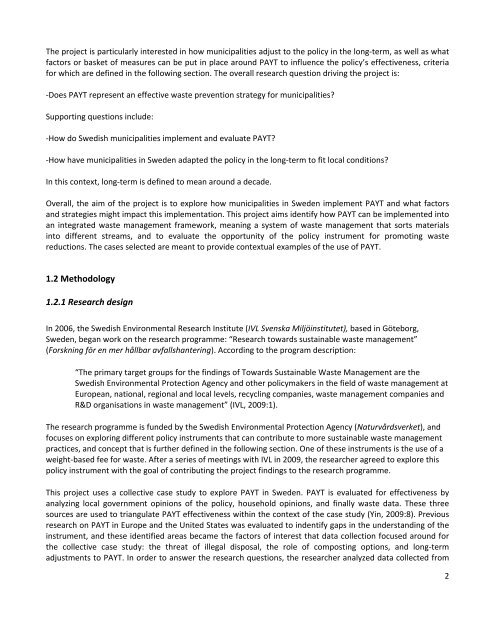Waste prevention and Pay as You Throw, a collective case ... - lumes
Waste prevention and Pay as You Throw, a collective case ... - lumes
Waste prevention and Pay as You Throw, a collective case ... - lumes
You also want an ePaper? Increase the reach of your titles
YUMPU automatically turns print PDFs into web optimized ePapers that Google loves.
The project is particularly interested in how municipalities adjust to the policy in the long‐term, <strong>as</strong> well <strong>as</strong> what<br />
factors or b<strong>as</strong>ket of me<strong>as</strong>ures can be put in place around PAYT to influence the policy’s effectiveness, criteria<br />
for which are defined in the following section. The overall research question driving the project is:<br />
‐Does PAYT represent an effective w<strong>as</strong>te <strong>prevention</strong> strategy for municipalities<br />
Supporting questions include:<br />
‐How do Swedish municipalities implement <strong>and</strong> evaluate PAYT<br />
‐How have municipalities in Sweden adapted the policy in the long‐term to fit local conditions<br />
In this context, long‐term is defined to mean around a decade.<br />
Overall, the aim of the project is to explore how municipalities in Sweden implement PAYT <strong>and</strong> what factors<br />
<strong>and</strong> strategies might impact this implementation. This project aims identify how PAYT can be implemented into<br />
an integrated w<strong>as</strong>te management framework, meaning a system of w<strong>as</strong>te management that sorts materials<br />
into different streams, <strong>and</strong> to evaluate the opportunity of the policy instrument for promoting w<strong>as</strong>te<br />
reductions. The c<strong>as</strong>es selected are meant to provide contextual examples of the use of PAYT.<br />
1.2 Methodology<br />
1.2.1 Research design<br />
In 2006, the Swedish Environmental Research Institute (IVL Svenska Miljöinstitutet), b<strong>as</strong>ed in Göteborg,<br />
Sweden, began work on the research programme: “Research towards sustainable w<strong>as</strong>te management”<br />
(Forskning för en mer hållbar avfallshantering). According to the program description:<br />
“The primary target groups for the findings of Towards Sustainable <strong>W<strong>as</strong>te</strong> Management are the<br />
Swedish Environmental Protection Agency <strong>and</strong> other policymakers in the field of w<strong>as</strong>te management at<br />
European, national, regional <strong>and</strong> local levels, recycling companies, w<strong>as</strong>te management companies <strong>and</strong><br />
R&D organisations in w<strong>as</strong>te management” (IVL, 2009:1).<br />
The research programme is funded by the Swedish Environmental Protection Agency (Naturvårdsverket), <strong>and</strong><br />
focuses on exploring different policy instruments that can contribute to more sustainable w<strong>as</strong>te management<br />
practices, <strong>and</strong> concept that is further defined in the following section. One of these instruments is the use of a<br />
weight‐b<strong>as</strong>ed fee for w<strong>as</strong>te. After a series of meetings with IVL in 2009, the researcher agreed to explore this<br />
policy instrument with the goal of contributing the project findings to the research programme.<br />
This project uses a <strong>collective</strong> c<strong>as</strong>e study to explore PAYT in Sweden. PAYT is evaluated for effectiveness by<br />
analyzing local government opinions of the policy, household opinions, <strong>and</strong> finally w<strong>as</strong>te data. These three<br />
sources are used to triangulate PAYT effectiveness within the context of the c<strong>as</strong>e study (Yin, 2009:8). Previous<br />
research on PAYT in Europe <strong>and</strong> the United States w<strong>as</strong> evaluated to indentify gaps in the underst<strong>and</strong>ing of the<br />
instrument, <strong>and</strong> these identified are<strong>as</strong> became the factors of interest that data collection focused around for<br />
the <strong>collective</strong> c<strong>as</strong>e study: the threat of illegal disposal, the role of composting options, <strong>and</strong> long‐term<br />
adjustments to PAYT. In order to answer the research questions, the researcher analyzed data collected from<br />
2
















